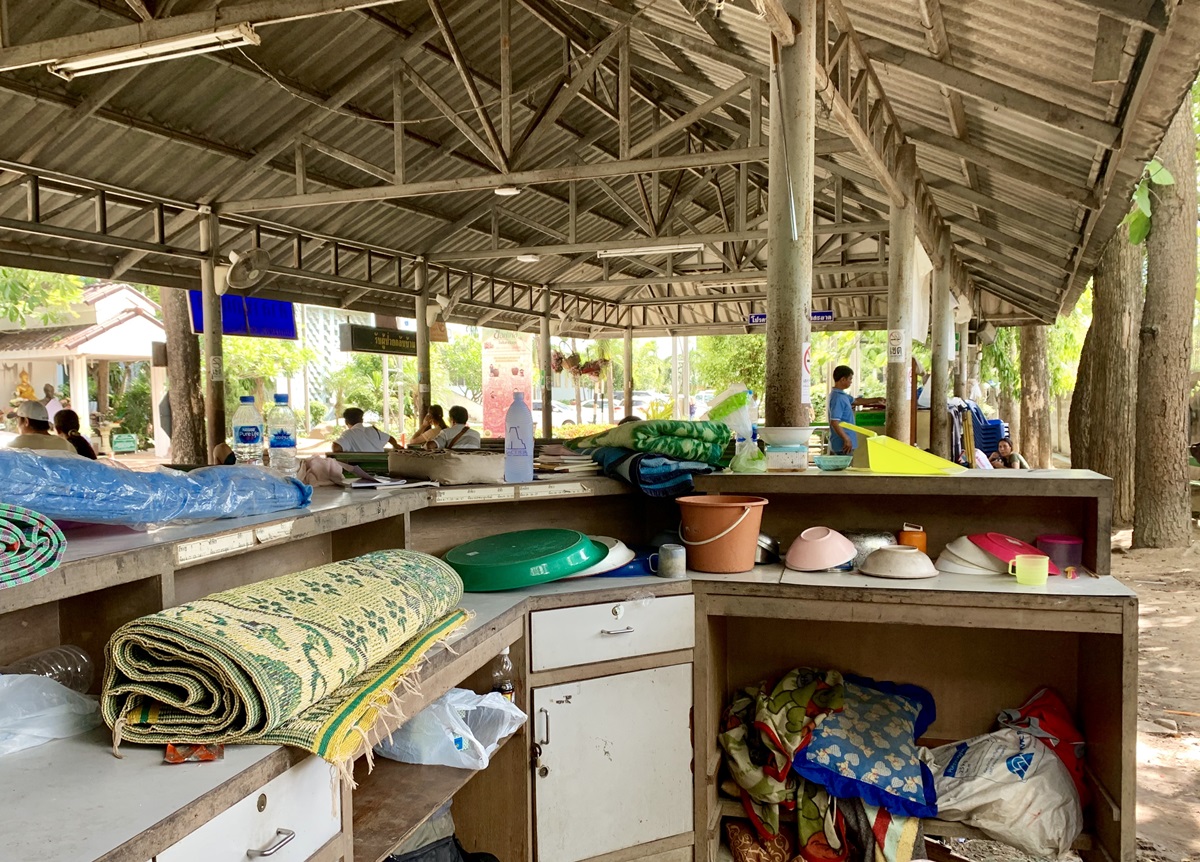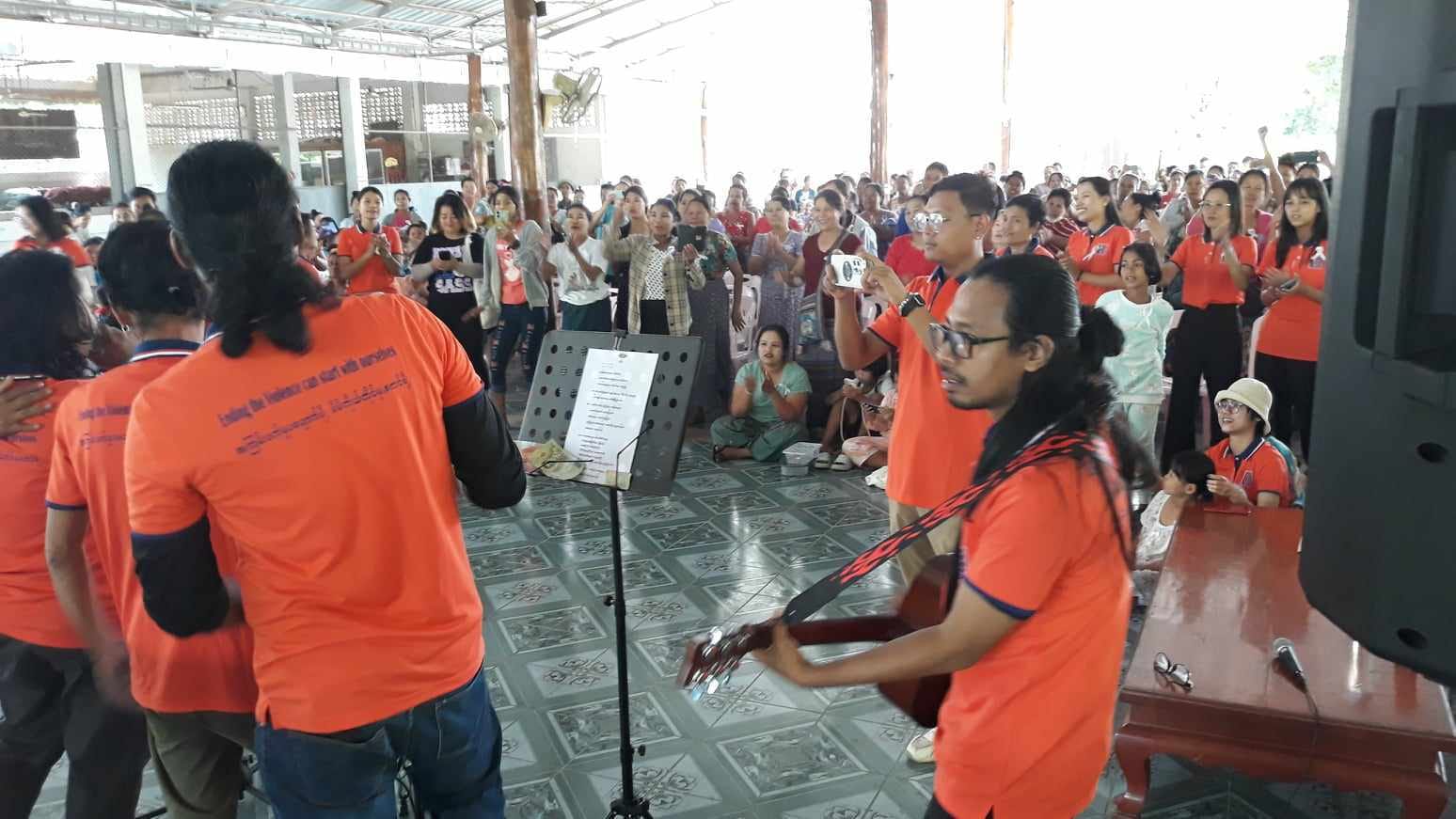Staff members and interns set out from the MAP Foundation around 2 pm and headed to a hospital located on the outskirts of Chiang Mai to visit Som, a woman who was suffering from coronary heart disease. It was the interns first time going inside the areas where the patients were kept. In the hospital, patients were kept in rows of six beds without anything separating them, giving them little privacy. This lack of privacy is likely due to the shortage of hospital space available to house patients.
Once the CHE team arrived at Som’s bed, they asked her how she was doing and made sure she was feeling ok. She replied very cheerfully and was happy to see the CHE team. One of the CHE team members recounted that they had known Som for 15 years, and how she came to one of the MAP emergency houses when she was younger and had been diagnosed with HIV. Prior to her struggles with remaining healthy, Som worked as a restaurant hostess in Bangkok before she became too sick to work. After she got married, she lived at home with her husband in her husband’s house. Unfortunately, after her husband died in a motor accident, she was left homeless. For the past few years she has been eating and sleeping at a Christian church in Thailand. The week before, the CHE team held a workshop about how to inform hospitals and families about how you want to be buried after death. Som found a way to make it to MAP and attended this workshop where she explained that she wanted the Christian church to take care of her burial and funeral. The CHE team was able to help her with this and also provided her with basic necessities like toothpaste, shower shoes, soap, and tissues. Som explained to the interns how MAP had been there for her almost every time she had been sick. Thanks to the advocacy that MAP has done for Som, they were able to get her things to help her live more comfortably and be buried the way she wants to. She thanked them and then told the CHE team that she needed to rest as she was recuperating from a recent surgery.
Following the visit with Som, the CHE team went to visit with Sai who was located at the same hospital. Sai was recuperating from a blood vessel that had recently burst in his brain. Prior to experiencing these neurological problems, Sai was a Shan soldier until he was 55, but after that he was discharged from the Shan army because he was too old. Following this, Sai got papers to be a migrant worker in Thailand where he worked until he had a brain aneurism. After his injury, Sai became paralyzed and has been unable to move below his waist and unable to speak. Once Sai was operated on at the hospital, they moved him to an area located just outside of the hospital that was provided to patients who were no longer in need of treatment but were disabled. The area had wooden benches with blankets that acted as beds for the patients, and a small kitchen and bathroom area. Since many hospitals do not have the room to house patients permanently but also want to refrain from putting them on the streets, many patients end up in similar situations.
Once the CHE team reached Sai, they offered to As part of the Community Health and Empowerment (CHE) sector of the MAP Foundation, MAP employees visit migrant workers dealing with various health related problems. On Friday June 7th, the MAP outreach team and the summer 2019 interns from Emory University visited two patients at a nearby hospital. One patient was suffering from coronary heart disease and another was recuperating from problems resulting from a blood vessel that had burst in his brain.
Staff members and interns set out from the MAP Foundation around 2 pm and headed to a hospital located on the outskirts of Chiang Mai to visit Som, a woman who was suffering from coronary heart disease. It was the interns first time going inside the areas where the patients were kept. In the hospital, patients were kept in rows of six beds without anything separating them, giving them little privacy. This lack of privacy is likely due to the shortage of hospital space available to house patients.
Once the CHE team arrived at Som’s bed, they asked her how she was doing and made sure she was feeling ok. She replied very cheerfully and was happy to see the CHE team. One of the CHE team members recounted that they had known Som for 15 years, and how she came to one of the MAP emergency houses when she was younger and had been diagnosed with HIV. Prior to her struggles with remaining healthy, Som worked as a restaurant hostess in Bangkok before she became too sick to work. After she got married, she lived at home with her husband in her husband’s house. Unfortunately, after her husband died in a motor accident, she was left homeless. For the past few years she has been eating and sleeping at a Christian church in Thailand. The week before, the CHE team held a workshop about how to inform hospitals and families about how you want to be buried after death. Som found a way to make it to MAP and attended this workshop where she explained that she wanted the Christian church to take care of her burial and funeral. The CHE team was able to help her with this and also provided her with basic necessities like toothpaste, shower shoes, soap, and tissues. Som explained to the interns how MAP had been there for her almost every time she had been sick. Thanks to the advocacy that MAP has done for Som, they were able to get her things to help her live more comfortably and be buried the way she wants to. She thanked them and then told the CHE team that she needed to rest as she was recuperating from a recent surgery.

Following the visit with Som, the CHE team went to visit with Sai who was located at the same hospital. Sai was recuperating from a blood vessel that had recently burst in his brain. Prior to experiencing these neurological problems, Sai was a Shan soldier until he was 55, but after that he was discharged from the Shan army because he was too old. Following this, Sai got papers to be a migrant worker in Thailand where he worked until he had a brain aneurism. After his injury, Sai became paralyzed and has been unable to move below his waist and unable to speak. Once Sai was operated on at the hospital, they moved him to an area located just outside of the hospital that was provided to patients who were no longer in need of treatment but were disabled. The area had wooden benches with blankets that acted as beds for the patients, and a small kitchen and bathroom area. Since many hospitals do not have the room to house patients permanently but also want to refrain from putting them on the streets, many patients end up in similar situations.
Once the CHE team reached Sai, they offered to help push his wheelchair to a more open area, but he kindly declined. Sai was still able to take care of himself despite the fact that he was paralyzed from the waist down. Despite all of the negative effects of his neurological issue, Sai still answered every question CHE asked him about his situation with a nod and an unwavering smile. Since Sai could not speak, the CHE team talked to others in the area around him to make sure that he was comfortable. They explained that he was doing well, and that people were feeding him so much that he was getting chubby. Thanks to the advocacy that MAP was able to do for Sai, the CHE team was able to provide him with 400 baht a month to help him buy food, necessary clothing items, get his nails cut, and pay his medical bills. Without the help of the MAP Foundation or the CHE team he may not have been able to provide himself with the bare necessities.
elp push his wheelchair to a more open area, but he kindly declined. Sai was still able to take care of himself despite the fact that he was paralyzed from the waist down. Despite all of the negative effects of his neurological issue, Sai still answered every question CHE asked him about his situation with a nod and an unwavering smile. Since Sai could not speak, the CHE team talked to others in the area around him to make sure that he was comfortable. They explained that he was doing well, and that people were feeding him so much that he was getting chubby. Thanks to the advocacy that MAP was able to do for Sai, the CHE team was able to provide him with 400 baht a month to help him buy food, necessary clothing items, get his nails cut, and pay his medical bills. Without the help of the MAP Foundation or the CHE team he may not have been able to provide himself with the bare necessities.







